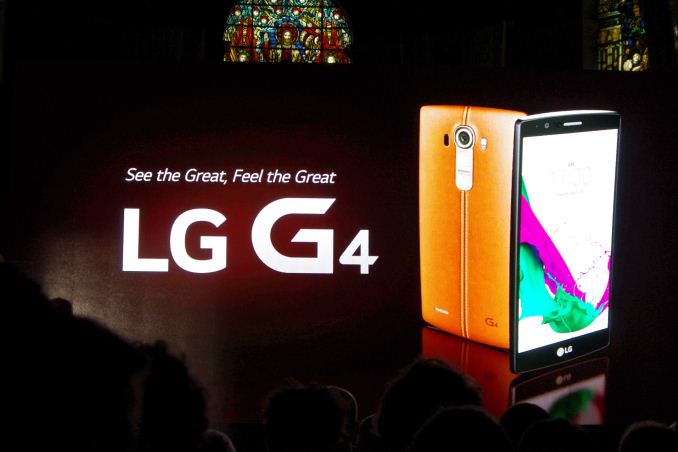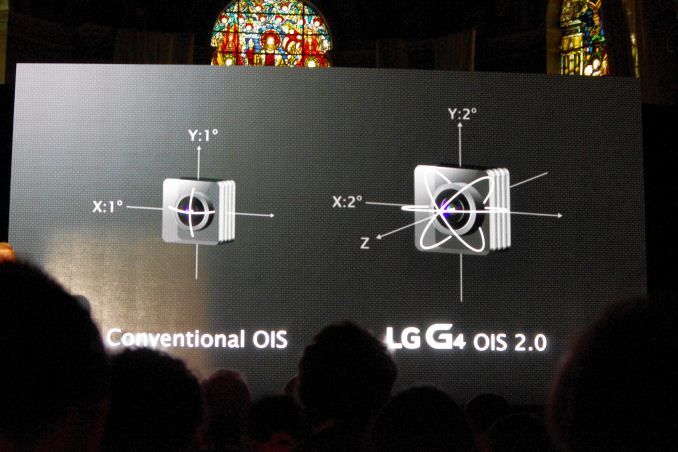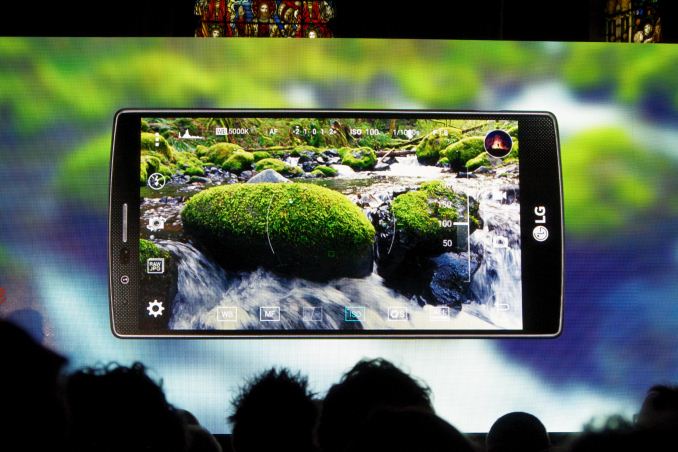LG Announces the G4: 5.5-inch QHD with Snapdragon 808
by Ian Cutress & Andrei Frumusanu on April 28, 2015 11:30 AM EST- Posted in
- Smartphones
- LG
- Mobile
- Snapdragon 808
- LG G4
- MSM8992

In a joint event between London and New York, LG has lifted the veil on the next iteration of its high-end smartphone, the G4. The G3's designs largely borrows from the G3 and iterates on it with a new slightly curved screen and optional leather back covers. The camera seems to be LG's core focus for this device, and we'll get back on those details in just a bit.
The G4 will be the first device to officially use the Snapdragon 808, Qualcomm’s MSM8992 big.LITTLE SoC arrangement that uses two ARM A57 cores in one cluster clocked in at 1.82GHz and four ARM A53s at 1.44GHz in the other. The GPU also uses a lower end Adreno 418 clocked in at 600MHz. Qualcomm avoided LPDDR4 in the S808, and thus remaines a LPDDR3 piece likely running at up to 933MHz.
While we're not too concerned with the resulting CPU performance and loss of two big cores, and slight frequency loss of the Snapdragon 808, it's the GPU which should see higher impact as 3D performance suffers a tad compared to the Snapdragon 810's Adreno 430. In our preliminary tests with the demo device, we see GFXBench Manhattan offscreen go down from 22.7fps to 15fps and T-Rex from 49fps down to 35fps when comparing the G4 to the HTC M9, which sports a FHD screen as opposed ot the QHD one we find in the LG device.
The detailed specification lists shows the iterative improvements over the G3, launched last year:
LG G3 |
LG G4 |
|
| SoC | MSM8974AC Snapdragon 801 4x Krait 400 @ 2.5 GHz |
MSM8992 Snapdragon 808 2xA57 @ 1.82GHz + 4xA53 @ 1.44GHz |
| GPU | Adreno 330 @ 578MHz | Adreno 418 @ 600MHz |
| RAM | 3GB LPDDR3 933MHz | 3GB LPDDR3 933MHz |
| NAND | 32GB NAND (eMMC 5.0) + microSD |
32GB NAND (eMMC 5.0) + microSD |
| Display | 5.5-inch 2560x1440 IPS LCD | 5.5-inch 2560x1440 IPS LCD |
| Network | 2G / 3G / 4G Qualcomm MDM9x25 UE Category 4 LTE |
2G / 3G / 4G Qualcomm X10 (Integrated) UE Category 9 LTE |
| Dimensions | 146.3 x 74.6 x 8.9 mm 149 grams |
148.9 x 76.1 x 6.3 - 9.8 mm 155 grams |
| Camera | 13MP rear camera, 1.12 µm pixels, 1/3.06" CMOS size, F/2.4. 2-axis OIS 2.1MP F/2.0 FFC |
16MP Sony IMX234 rear camera, 1.12µm pixels, 1/2.6" CMOS size F/1.8, 3-axis OIS 8MP Toshiba T4KA3 FFC |
| Battery | 3000 mAh (11.4 Wh) replaceable | 3000 mAh (11.4 Wh) replaceable |
| OS | Android 4.4.2 with LG UI | Android 5.1 with LGUX 4.0 |
| Connectivity | 802.11a/b/g/n/ac + BT 4.0, USB2.0, GPS/GNSS, MHL, DLNA, NFC | 802.11a/b/g/n/ac + BT 4.0 |
| SIM Size | MicroSIM | NanoSIM |
The screen size and resolution stay constant at 5.5" and QHD, but the device has an angular element to it, similar to the LG G Flex 2 but not as pronounced: The screen is touted to be a new generation IPS Quantum display. It looks like LG is claiming 20% gamut increase. The display has 50% increased contrast over the G3, achieving a total of 1500:1 contrast ratio. The G4 reintroduces Panel Self Refresh which was unfortunately missing from the G3, and this should vastly improve battery life over its predecessor.
The screen has a 3000mm radius curve throughout the phone's design that LG markets as "Slim Arc" design.
The phone comes in several different plastic and leather cover options. These are high-quality hand-produced genuine leather products. The plastic version sports a diamond pattern mimicking a metallic look. This also means the G4 is slightly bigger and heavier than the G3 as it comes at a increased 155g. The removable battery of the G4 remains similar to the G3 at 3000 mAh, and the SIM moves to the nano-size. The microSD slot remains an option for the G4.
The G4 gets a camera update, moving from a 13MP to a 16MP design that migrates from an F/2.4 to F/1.8, allowing for potentially better performance. We find a Sony IMX234 sensor, a unit we haven't yet seen used in any other devices. LG were keen to point the F/1.8 over Samsung’s F/1.9 on the latest Galaxy S6. The new OIS system dubbed "OIS 2.0" now offers a 3-axis gyroscope instead of the traditional 2-axis implementations in all current OIS devices. Another first is the implementation of a colour spectrum sensor next to the flash unit, and is able to read RGB and infrared light. LG is able to vastly improve white-balance and also increase clarity for more natural pictures.

The phone now also offers full manual control, with customizable ISO, exposure, shutter speed and white balance among other things. RAW format capture is also supported. Double clicking on the rear buttons already takes a picture within a second, LG is here taking another stab at Samsung's S6 as it only is able to open the camera app in the same time.
The front camera has been boosted to a 8MP Toshiba T4KA3 sensor and sports an improved gesture shot triggering function.
The volume rocker on the rear changes slightly, moving to a flatter central piece. The flash element of the camera in this area is a dual LED design, and we also find the microphone grille at the bottom. One of the elements LG seems to be pushing with the G4 is the design of the back cover, allowing for a replaceable leather rear while retaining the front facia that exhibits a faux carbon-fibre effect of sorts.
The device should be available this week in major markets. We’re currently waiting in line to get some hands-on time with the device, and hopefully on the list to get a sample to follow up from the LG G3 review.












121 Comments
View All Comments
nerd1 - Tuesday, April 28, 2015 - link
It's so laughable in every ways... 808 ap (worse than 805, no DDR4). Misleading marketing all around (IPS quantum display - which is NOT a quantum dot display), boasting 1/2.6" camera sensor (the same size as gs6), and f1.8 is negligibly faster than f1.9.Now old and discounted galaxy note 4 is better in just every ways, it's almost sad.
SunLord - Tuesday, April 28, 2015 - link
I have to wonder if we will see another LG phone announced this year around the same time as the note 5 given the G4's lower spec I almost expect it to be cheaper leaving room for a true flagship to take on the Note 5 and S6 this fall. The lower specs also give me hope for a new lower cost nexus 5 based off itname99 - Wednesday, April 29, 2015 - link
And if people (ie the non-geek 99%) bought phones based on specs, this would be an actual issue.Last time I checked, AMD seems to survive OK selling low-end CPUs for low-end PCs. And Intel sells plenty of Celerons and Pentiums.
BoneAT - Tuesday, April 28, 2015 - link
Okay, put the problematic SD810 aside for the moment...So can someone give me a sound explanaition why go with the SD808 over the more powerful, more refined and graphically higher performing SD805? Qualcomm is clearly isn't quite ready for bit.LITTLE and these Cortex-A57 ARM cores, where the SD805 was the icing on the Krait cake, yet I can't count a total of five devices that have it.
Is it the 64 bit marketing?
extide - Tuesday, April 28, 2015 - link
Yup, 64-bit marketing.mczak - Tuesday, April 28, 2015 - link
I'm not entirely sure that's the only reason. Don't forget the 805 is just an AP without the modem integrated, that might also play a role.Besides, I'm not yet 100% convinced it's really always inferior. Though actually the gpu should be, if I see that right the 418 and 420 are actually mostly the same (the 418 is newer so might have some fixes but overall the unit count is the same) but the 420 has nearly twice the memory bandwidth at its disposal. We'll see how it really fares in benchmark and power consumption soon enough.
Vegator - Tuesday, April 28, 2015 - link
A few reasons for using SD808 over SD805:The SD805 is a more expensive, ultra-high-end design. It has a dual-channel 64-bit memory interface, much wider than the dual-channel memory interface of SD808. Additionally, SD805 does not have an integrated modem, requiring a separate modem chip in a smartphone. The SD808 does integrate a modem. Overall, using the SD808 allows lower cost and a much smaller form factor (less chips). There is a reason why SD805 isn't used in a lot of smartphones (a game console was recently announced using the chip, which makes sense given its specs).
Android 5 also takes advantage of cryptography instructions that are present in ARMv8 but missing in previous generation SoCs such as SD805. I don't know the details but I've read this is important when the recommended whole-device encryption is enabled.
BoneAT - Tuesday, April 28, 2015 - link
Thank you, this definitely makes a lot of sense. Interesting on the integrated modem side, didn't know the SD805 uses a separate one. Still, for an expensive device cost shouldn't be a problem, and the G4 really is expensive. A downclocked SD810 with an also lower-capped Adreno 430 just makes more sense for a QHD display IMO, and there'S the worry. SD808 sounds like a great solution for Full HD. QHD is a different story.jospoortvliet - Thursday, April 30, 2015 - link
Well it is claimed to be 20%faster than the chip in a he also-QHD G3 so it should not be a huge dealbreaker.uhuznaa - Tuesday, April 28, 2015 - link
That leather back actually is nice, but this particular design with the vertical groove and the buttons/camera towards the top is a little bit suggestive... at least there is no pink version ;-)